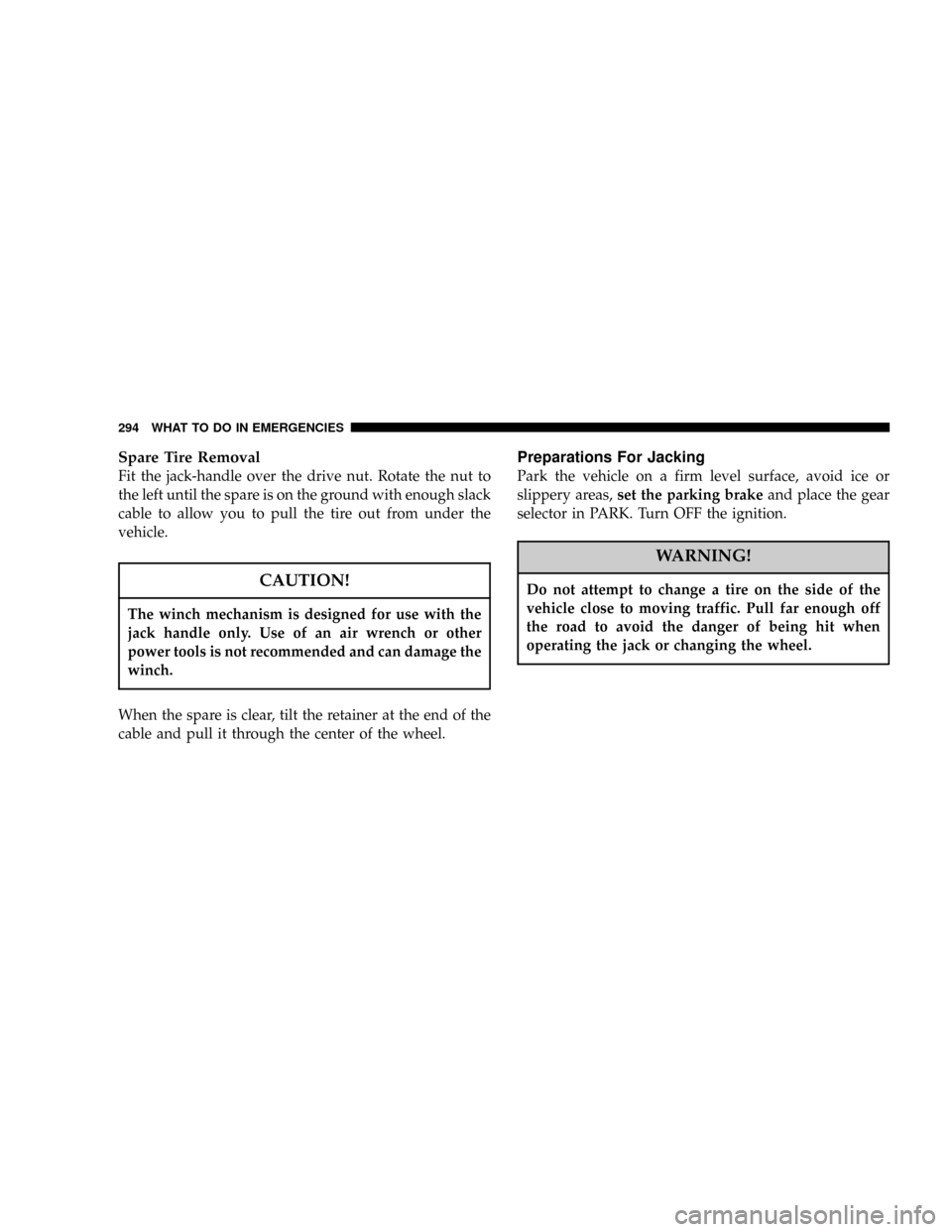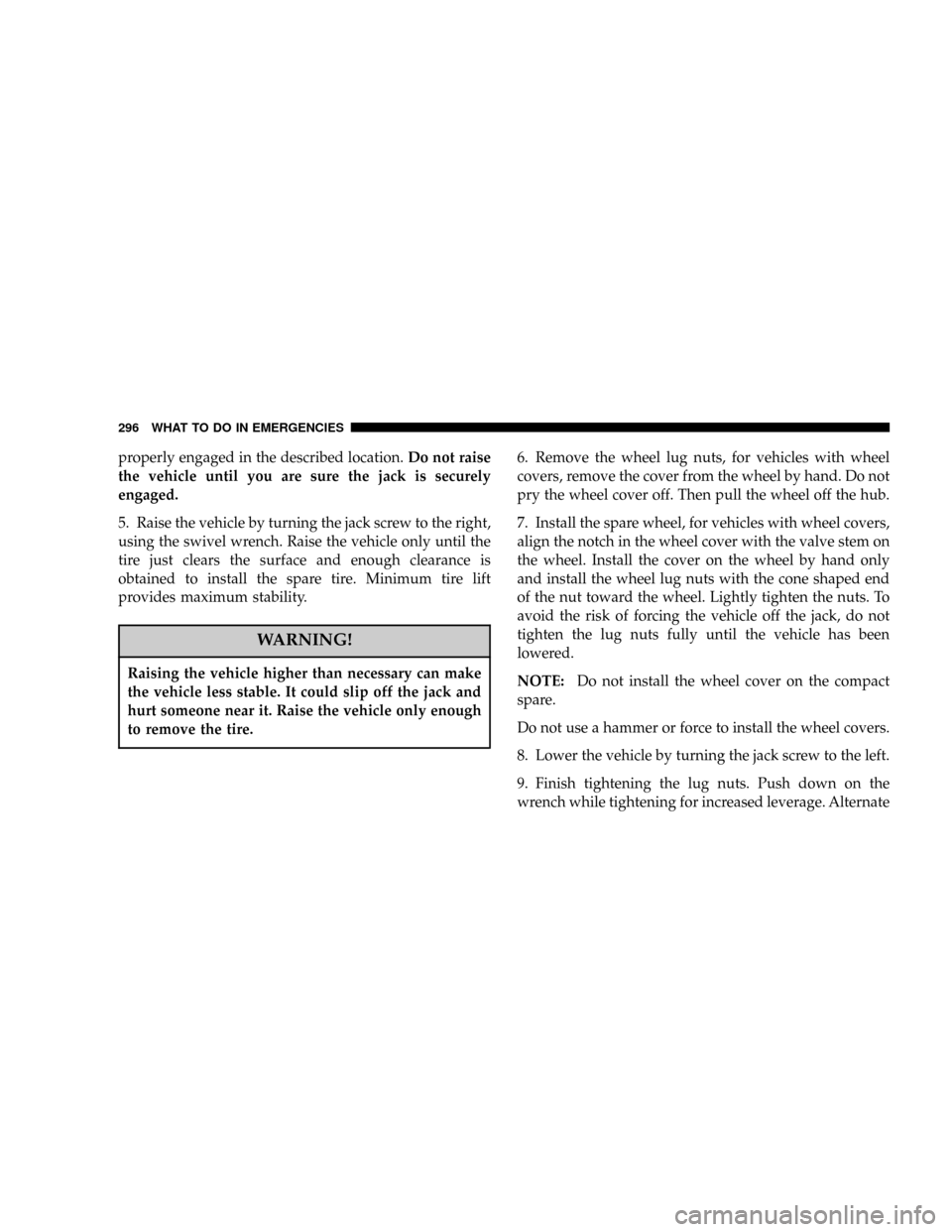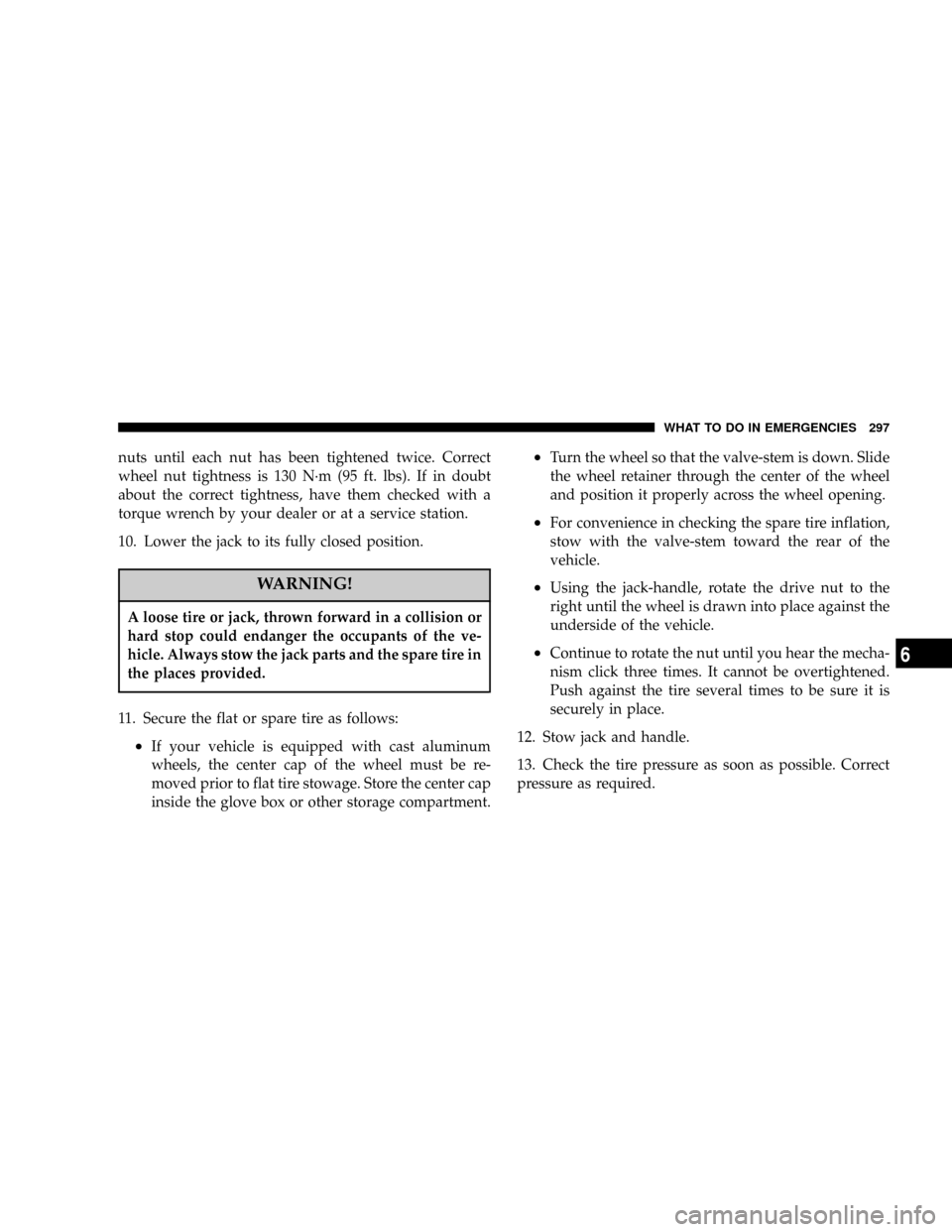wheel CHRYSLER TOWN AND COUNTRY 2004 4.G Owner's Guide
[x] Cancel search | Manufacturer: CHRYSLER, Model Year: 2004, Model line: TOWN AND COUNTRY, Model: CHRYSLER TOWN AND COUNTRY 2004 4.GPages: 401
Page 268 of 401

Improper alignment will not cause vehicle vibration.
Vibration may be a result of tire and wheel out-of-
balance. Proper balancing will reduce vibration and
avoid tire cupping and spotty wear.
ALL WHEEL DRIVE (AWD) Ð IF EQUIPPED
CAUTION!
All Wheel Drive (AWD) vehicles must have the same
size and type tires on all wheel positions. Unequal
tire sizes must not be used. Unequal tire size may
cause failure of the power transfer unit and/or the
viscous coupling.
TIRE PRESSURE MONITOR SYSTEM Ð IF
EQUIPPED
The Tire Pressure Monitor System (TPM) system uses
wireless technology with wheel rim mounted electronic
sensors to monitor tire pressure levels (EXCLUDING
THE SPARE TIRE). Sensors, mounted to each wheel as
part of the valve stem, transmit tire pressure readings to
a receiver located in the overhead console.
NOTE:The tire pressure monitoring system on your
vehicle will warn you when one of your tires is signifi-
cantly underinflated and when some combinations of
your tires are significantly underinflated. However, there
are other combinations of significantly underinflated
tires for which your tire pressure monitoring system may
not warn you. These other combinations are relatively
common, accounting for approximately half the instances
in which vehicles have significantly underinflated tires.
For example, your system may not warn you when both
tires on the same side or on the same axle of your vehicle
268 STARTING AND OPERATING
Page 270 of 401

TIRE PRESSURE NOW AVAILABLE
The TPM system is functioning normally and the external
interference is no longer affecting the system.
SPARE TIRE IN USE? YES/NO
The TPM system requires more information to determine
the correct mode of operation, one or more of the vehicle
active tires has been replaced by the spare, a wheel rim
not equipped with a TPM sensor or the TPM system
requires service.
If the spare tire or non TPM sensor equipped wheel rim
is in active use (mounted on the vehicle), answer YES and
the TPM system will resume normal operation.
If the spare tire or non TPM sensor equipped wheel rim
isNOTin active use (mounted on the vehicle), answer
NO and the TPM system will resume normal operation.
ALL 5 TIRES WITH CAR? YES/NO
The TPM system requires more information to determine
the correct mode of operation, one or more of the vehicle
active tires has been replaced by the spare, a wheel rim
not equipped with a TPM sensor or the TPM system
requires service.
If the spare tire or non TPM sensor equipped wheel rim
is in active use (mounted on the vehicle), answer YES and
the TPM system will resume normal operation.
If the spare tire or non TPM sensor equipped wheel rim
isNOTin active use (mounted on the vehicle), answer
NO and the TPM system will resume normal operation.
270 STARTING AND OPERATING
Page 271 of 401

CAUTION!
The TPM system has been optimized for the original
equipment tires and wheels. TPM system pressures
have been established for the tire size equipped on
your vehicle. Undesirable operation or sensor dam-
age may result when using replacement equipment
that is not of the same size, type, and/or style.
After-market wheels can cause sensor damage. Do
not use tire sealant or balance beads if your vehicle
is equipped with TPM system as damage to the
sensors may result.
NOTE:
²The TPM system can inform the driver of a low tire
pressure condition of 28 psi [1.9 bars] (193 kPa) or less,
or high a tire pressure condition of 48 psi [3.3 bars]
(330 kPa) or more.
²The TPM system is not intended to replace normal tire
care and maintenance, nor to provide warning of a tire
failure or condition.
²The TPM system should not be used as a tire pressure
gauge while adjusting your tire pressure.
²The TPM system must be retrained after a tire rotation
or wheel rim mounted sensor replacement. See your
authorized dealer for service.
CAUTION!
After inspecting or adjusting the tire pressure al-
ways reinstall the valve stem cap. This will prevent
moisture and dirt entry into the valve stem, which
could damage the wheel rim sensor.
STARTING AND OPERATING 271
5
Page 272 of 401

General Information
This device complies with part 15 of the FCC rules and
RSS 210 of Industry Canada. Operation is subject to the
following conditions:
²This device may not cause harmful interference.
²This device must accept any interference received,
including interference that may cause undesired op-
eration.
The tire pressure sensors are covered under one of the
following licenses:
United States.....................KR5S120123
Canada........................2671-S120123
TIRE CHAINS
Use only compact chains, or other traction aids that meet
SAE type ªClass Sº specifications. Chains must be the
proper size for the vehicle, as recommended by the chain
manufacturer.
NOTE:Do not use tire chains on a compact spare tire.
CAUTION!
To avoid damage to your vehicle or tires, observe the following
precautions:
²Because of restricted chain clearance between tires and
other suspension components, it is important that only
chains in good condition are used. Broken chains can cause
serious damage. Stop the vehicle immediately if noise
occurs that could indicate chain breakage. Remove the
damaged parts of the chain before further use.
²Install chains on the front wheels as tightly as possible and
then retighten after driving about1¤2mile (0.8 km).²Do not exceed 45 mph (70 km/h).
²Drive cautiously and avoid severe turns and large
bumps, especially with a loaded vehicle.
²Do not use on rear wheels of All Wheel Drive (AWD)
vehicles.
²Do not drive for prolonged period on dry pavement.
²Observe the tire chain manufacturer's instructions on the
method of installation, operating speed, and conditions for
use. Always use the lower suggested operating speed of the
chain manufacturer if different than the speed recom-
mended by the manufacture.
272 STARTING AND OPERATING
Page 282 of 401

²Vehicle Identification Number (VIN)
²Type of Vehicle
²Month Day and Hour of Manufacture (MDH)
The bar code allows a computer scanner to read the
Vehicle Identification Number (VIN).
Gross Vehicle Weight Rating (GVWR)
The GVWR is the total allowable weight of your vehicle.
This includes driver, passengers, and cargo. The total
load must be limited so that you do not exceed the
GVWR.
Gross Axle Weight Rating (GAWR)
The GAWR is the maximum capacity of the front and rear
axles. Distribute the load over the front and rear axles
evenly. Make sure that you do not exceed either front or
rear GAWR.
WARNING!
Because the front wheels drive and steer the vehicle, it is
important that you do not exceed the maximum front or
rear GAWR. A dangerous driving condition can result if
either rating is exceeded. You could lose control of the
vehicle and have an accident.
Overloading
The load carrying components (axle, springs, tires,
wheels, etc.) of your vehicle will provide satisfactory
service as long as you do not exceed the GVWR and
front and rear GAWR.
The best way to figure out the total weight of your
vehicle is to weigh it when it is fully loaded and ready
for operation. Weigh it on a commercial scale to insure
that it is not over the GVWR.
Figure out the weight on the front and rear of the vehicle
separately. It is important that you distribute the load
evenly over the front and rear axles.
282 STARTING AND OPERATING
Page 289 of 401

WHAT TO DO IN EMERGENCIES
CONTENTS
mHazard Warning Flasher..................290
mIf Your Engine Overheats.................291
mJacking And Tire Changing................292
NJack Location........................293
NSpare Tire Stowage....................293
NPreparations For Jacking................294
NJacking Instructions....................295
mJump-Starting Procedures If Battery Is Low....298
mDriving On Slippery Surfaces..............299
NAcceleration.........................299NTraction............................300
mFreeing A Stuck Vehicle..................300
mTowing A Disabled Vehicle................301
NWith Ignition Key.....................301
NWithout The Ignition Key...............302
NTowing This Vehicle Behind Another Vehicle
(Flat Towing With All Four Wheels On The
Ground)............................302
NTowing This Vehicle Behind Another Vehicle
With A Tow Dolley....................303
6
Page 294 of 401

Spare Tire Removal
Fit the jack-handle over the drive nut. Rotate the nut to
the left until the spare is on the ground with enough slack
cable to allow you to pull the tire out from under the
vehicle.
CAUTION!
The winch mechanism is designed for use with the
jack handle only. Use of an air wrench or other
power tools is not recommended and can damage the
winch.
When the spare is clear, tilt the retainer at the end of the
cable and pull it through the center of the wheel.
Preparations For Jacking
Park the vehicle on a firm level surface, avoid ice or
slippery areas,set the parking brakeand place the gear
selector in PARK. Turn OFF the ignition.
WARNING!
Do not attempt to change a tire on the side of the
vehicle close to moving traffic. Pull far enough off
the road to avoid the danger of being hit when
operating the jack or changing the wheel.
294 WHAT TO DO IN EMERGENCIES
Page 295 of 401

²Turn on the Hazard Warning Flasher.
²Block both the front and rear
of the wheel diagonally oppo-
site the jacking position. For
example, if changing the right
front tire, block the left rear
wheel.
²Passengers should not remain in the vehicle when the
vehicle is being jacked.
Jacking Instructions
1. Remove the spare wheel, scissors jack and jack-handle
from stowage.
2. Loosen (but do not remove) the wheel lug nuts by
turning them to the left one turn while the wheel is still
on the ground.3. There are two jack engagement locations on each side
of the body Ð see illustration.
4. These locations are on the sill flange of the body and
consist of a pair of downstanding tabs. The jack is to be
located, engaging the flange, between the pair of tabs
closest to the wheel to be changed. Place the wrench on
the jack screw and turn to the right until the jack head is
WHAT TO DO IN EMERGENCIES 295
6
Page 296 of 401

properly engaged in the described location.Do not raise
the vehicle until you are sure the jack is securely
engaged.
5. Raise the vehicle by turning the jack screw to the right,
using the swivel wrench. Raise the vehicle only until the
tire just clears the surface and enough clearance is
obtained to install the spare tire. Minimum tire lift
provides maximum stability.
WARNING!
Raising the vehicle higher than necessary can make
the vehicle less stable. It could slip off the jack and
hurt someone near it. Raise the vehicle only enough
to remove the tire.
6. Remove the wheel lug nuts, for vehicles with wheel
covers, remove the cover from the wheel by hand. Do not
pry the wheel cover off. Then pull the wheel off the hub.
7. Install the spare wheel, for vehicles with wheel covers,
align the notch in the wheel cover with the valve stem on
the wheel. Install the cover on the wheel by hand only
and install the wheel lug nuts with the cone shaped end
of the nut toward the wheel. Lightly tighten the nuts. To
avoid the risk of forcing the vehicle off the jack, do not
tighten the lug nuts fully until the vehicle has been
lowered.
NOTE:Do not install the wheel cover on the compact
spare.
Do not use a hammer or force to install the wheel covers.
8. Lower the vehicle by turning the jack screw to the left.
9. Finish tightening the lug nuts. Push down on the
wrench while tightening for increased leverage. Alternate
296 WHAT TO DO IN EMERGENCIES
Page 297 of 401

nuts until each nut has been tightened twice. Correct
wheel nut tightness is 130 N´m (95 ft. lbs). If in doubt
about the correct tightness, have them checked with a
torque wrench by your dealer or at a service station.
10. Lower the jack to its fully closed position.
WARNING!
A loose tire or jack, thrown forward in a collision or
hard stop could endanger the occupants of the ve-
hicle. Always stow the jack parts and the spare tire in
the places provided.
11. Secure the flat or spare tire as follows:
²If your vehicle is equipped with cast aluminum
wheels, the center cap of the wheel must be re-
moved prior to flat tire stowage. Store the center cap
inside the glove box or other storage compartment.
²Turn the wheel so that the valve-stem is down. Slide
the wheel retainer through the center of the wheel
and position it properly across the wheel opening.
²For convenience in checking the spare tire inflation,
stow with the valve-stem toward the rear of the
vehicle.
²Using the jack-handle, rotate the drive nut to the
right until the wheel is drawn into place against the
underside of the vehicle.
²Continue to rotate the nut until you hear the mecha-
nism click three times. It cannot be overtightened.
Push against the tire several times to be sure it is
securely in place.
12. Stow jack and handle.
13. Check the tire pressure as soon as possible. Correct
pressure as required.
WHAT TO DO IN EMERGENCIES 297
6